Rush hour in Saigon. Note the total lack of automobiles in 1994!
Be sure to visit our Photo Galleries for more spectacular images of our travels! (Pbase Galleries
When Viet Nam opened up to the west again in 1994, Lien told me that we were heading over there immediately. Secretly I was hoping to head over to Africa or someplace a tad more exotic, but heck, she was the boss! And travel is travel, right? I knew this was to be a momentous trip for her as she had not even dreamt of returning to Viet Nam since she left it nearly 20 years earlier during the last hours of the Viet Nam war, but she was always very interested in learning more about her Vietnamese heritage and family who were unable to immigrate to the US.
Lien left Viet Nam as one of the first refugees from the war. There is a Life Magazine image of her and her family leaving on April 30, 1975 from the roof of the US Embassy during the final hours of the Viet Nam war. I have been hearing for years how her family was rushed to the Embassy by her father, who was an officer in the SVA (South Vietnamese Army) to avoid persecution at the hands of the VC who were quickly entering Saigon. She told me of the violence she witnessed at the embassy as the throngs of people tried to escape. Her family made it to the US Embassy during the final hours of the entire conflict and were helicoptered to the US Hancock, which was ironically my father’s ship!
Lien had always been very proud of her culture. She and I co-authored many publications of her refugee experience and part of her story was even incorporated into the famous play titled, “Passages”. Up to 1994, returning to Viet Nam was merely a dream that she and many other Vietnamese expats had. That year Viet Nam officially opened up to the west and we were allowed to travel to the country with legal visas. We wasted no time at all getting to San Francisco to get our visas at the newly opened Viet Nam Consulate. Next thing I knew, I was heading to Southeast Asia with Lien and her brother, Dung. I had no idea what to expect.

Downtown Saigon, otherwise known as Tam Pho Ho Chi Minh
Arriving at Tan Son Nhat Airport in Saigon (now known as Ho Chi Minh City) was surreal. Seeing the American graffiti still scrawled all over the hangers and brick walls of the airport almost allowed me to forget that the Viet Nam war was over 20 years ago. Peace symbols and other 60’s era etchings were everywhere. I was seated next to an ex-marine who was returning to Viet Nam to “make peace” with the war and what he had done. I didn’t pry.
As we left the plane and made our way to the reception area, Lien and her brother (who was wheel chair-bound due to polio) immediately recognized her family, all two dozen of them! I cannot imagine what was going through their minds. Lien and Dung were basically American now, having spent the last twenty years growing up in the states. Lien was only ten when she came to the US. Now they were faced with the family she had not seen in so long. Vietnamese families are very close. Even the aunts and uncles are allowed parental roles over their nieces and nephews. And Lien told me that she was particularly close with this aunt and her family.
I remember greeting her family in my very basic Vietnamese and hearing the reaction of not only her family, but the entire reception crowd! They broke in to applause when they heard me utter the phrase, “chao ko, khoe khong?”, "Hello Aunt, how are you?"
Our ride through Saigon to the Aunt’s house was like a trip through a PBS Viet Nam special documentary. The scenes were right out of a history book. The only thing missing were the GI’s! I was actually in Viet Nam.
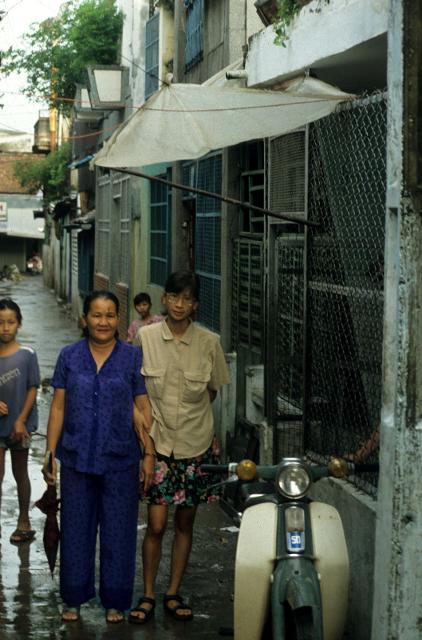
Lien and her aunt Phuoc, in front of her home in central Saigon
We eventually made it to Lien’s aunt’s small home in the bowels of Saigon. The looks of the people in the market we had to walk through and the alley way that led up to their home were those of astonishment. There were many who had never seen an American. I kept hearing the word, “ling so”, as I walked by people. Later I found out that this translated to “Soviet Russian”. This made sense since the only white people they had seen for the past decades were Soviets. I chuckled when I found out that the only difference between Soviets and Americans were that Americans were just Soviets with money.
We tried to sleep in Lien’s aunt’s house for our first night in Viet Nam, but the noise of the neighborhood and the house was too much for me. We were there in the middle of the rainy season, and the streets were flooding daily and the smells from the nearby market were absolutely overwhelming. Durian was in season and I thought the sewers were backing up. Maybe they actually were, who knows. The smells are so similar.
We used my “American-ness” as an excuse to start sleeping at a local hotel. For a few bucks a night, I had a clean and quiet bed. I was worried that I would offend the Aunt but Lien was usually very diplomatic in smoothing out sorts of things. We spent a couple weeks in and around Saigon with the family. It was truly amazing watching Lien catch up with her family and her old neighborhood. We visited her old school and met some of her classmates who actually remembered her and her family. The reunion for Lien was immensely powerful and emotional.
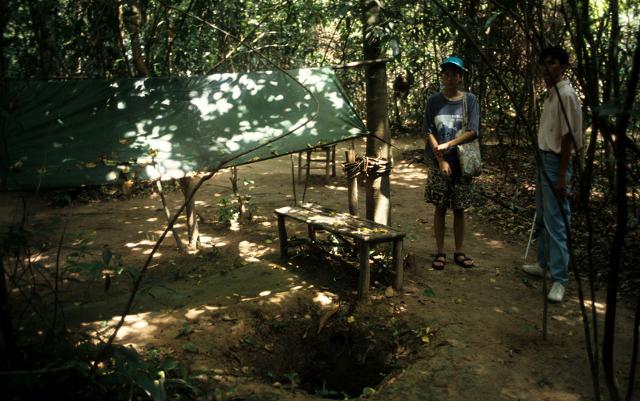
Cu Chi Tunnels: When I saw these, I understood why we lost the war!
While in Saigon, we visited such places as the National Museum, the Cu Chi Tunnels, the Mekong Delta, Vung Tao, and many other locations. I felt I had a very good sense of what Saigon was all about. By this time, my Vietnamese was getting to be pretty good and I was able to head out a bit on my own without my 98-pound wife to help and protect me. I woke early than Lien every day and I would head out to the main park in Saigon and hang out with the throngs of locals who were hacky-sacking or practicing their Tai Chi, or sipping tea. I would eat my morning Pho and experience what it was to be in Saigon, Viet Nam. And being associated with Lien and her family, I was already so far off the tourist track, it wasn’t funny. I was an insider in every sense. And the fact that I was becoming more and more conversant in Vietnamese made it even easier to be there.
After a couple weeks, we decided to take a journey for a few weeks. We arranged a driver to take us up to Hanoi for an extended trip. We thought we had taken all of the precautions against being ripped off but only about an hour outside of Saigon, our asshole driver decided to change the terms of our contract. The prices started to change and he wanted the entire payment for the whole trip right then and there. If we refused, he threatened to drop us off in the nearest rice field and leave us in the countryside. This was a common practice evidently in Viet Nam as we met several travelers who had the same experience while we were there. I was somewhat savvy however, ad I told him that we had to at least get to the next town in order to get the cash to pay him, so he would have to wait until there. I knew this prick was going to nickel and dime us all the way so I decided to ditch him in the next town, which just so happened to be Dalat, a beautiful central highlands town in the cool, lake and pine district about four hours to the north of Saigon. I knew we were likely to be able to procure more transportation there as we were to visit another one of Lien’s aunts.
So as soon as we arrived in Dalat, I unloaded our luggage, gave the driver the money I owed him for gas up to this point and told him to screw himself! He was pissed! I could care less as he had just tried to royally rip us off and he has shit to me. Lien agreed. He started to make a scene at Lien’s aunt’s home in central Dalat demanding more money. We explained to her aunt what he tried to do and Lien’s aunt went ballistic on him! Whatever she said to him, he tucked his tail and got the heck out of dodge! I found out later than Lien’s aunt was a fairly well-connected lady in Dalat and she threatened to put a contract out on him if he didn’t just shut up and get out. At the time, all this was pretty tense but now it’s basically just a cool story.

Lien's Da Lat in front of her home in Da Lat.
Lien’s aunt was amazing. She had spent years in a VC prison for her “capitalistic ways” (she tried to sell goods on the street when the VC took over and that was evidently illegal…). She was also educated and had American and French friends in the past. The VC were basically completely uneducated buffoons who had no governmental experience at all. Twenty years of their control really made Viet Nam a mess. I enjoyed listening to her aunt’s stories about her time in prison and with the idiotic VC. She had not seen her sons in years. She was hopeful that they had made it to the US, but they had not been heard from since they walked in to Cambodia nearly 15 years prior. Most likely they were killed by the Khmer Rouge. Lien’s brother-in-law made this trek of over 500 miles to escape the wrath of the VC. When his family was stopped by the Khmer Rouge, they were prepared to be slaughtered as was the normal practice of this vicious group. But as the Khmer Rouge soldiers were preparing to execute the entire family, a French Red Cross truck filled with bags of rice came up on the scene. The French bargained for the lives of the helpless refugees. They finally negotiated a price of two bags of rice per person! Unfortunately this was not enough for all of the family members. The elderly in the group ordered the younger ones to go with the French saviors and they would stay back to be killed by the Khmer Rouge. They did and they were killed right in front of the other family members! Stories of this nature are so common from this area during this time that they are almost cliché. But now I know what the life of a person is worth: two bags of rice.
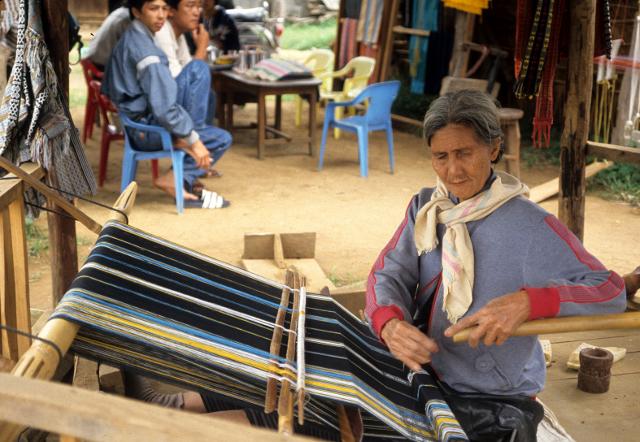
A "Lat" hill tribe woman weaving their beautiful fabrics in the countryside near Dalat.
I very much enjoyed the reunion between Lien and her aunt in Dalat. We traveled the countryside for many days. I was personally enjoying the cool mountain weather, and the bug collecting was pretty good too! We visited the Lake District and rented some horses from the famous “Dalat Cowboys”. I don’t even think they had heard of the Dallas Cowboys, but the name was too close not to chuckle. We visited the villages of the “Lat” hill tribe. On one occasion, a Lat woman grabbed Lien and started sobbing. Her Vietnamese was a bit rough, but through a translator, we learned that she was convinced that Lien was her reincarnated daughter. She seemed so sincere and was not asking for a thing, so I don’t think she was scamming us. She was serious.

The poacher's living room near Dalat filled with slaughtered wildlife. I could have killed him.

A living Clouded Leopard in the poachers "back room". For a mere $500...
While walking the back streets of Dalat one night, Lien and I saw a home that seemed to be filled with stuffed and mounted animals. I told Lien that I wanted to see what this house was and she thought I was crazy. There was no way she was going to allow me to go in that house. That is when I approached a man standing in front an introduced myself and gestured to see if we could enter. The next thing I remember is being in this home filled with hundreds of very poorly stuffed animals. I was in a very serious poacher’s house. It was all I could do to keep from vomiting when I saw so many rare and endangered species stuffed in repulsive and idiotic poses. There were three Clouded Leopards stuffed on his counter. I could not believe what I was seeing. Somehow, he must of thought I was a prospective customer, and he wanted to know if I wanted to go in to his “back room”. There I found two LIVING Clouded Leopards and one Asian Wild Cat. For $500, I could have these amazing animals. I was thoroughly disgusted. It was on this evening that I realized the extent to which Asia was losing its fauna to greedy pricks like this. This man was rich. He was not hungry. This was about money and greed and had nothing to do with a starving family struggling to make a living. That argument lost steam with me this evening.
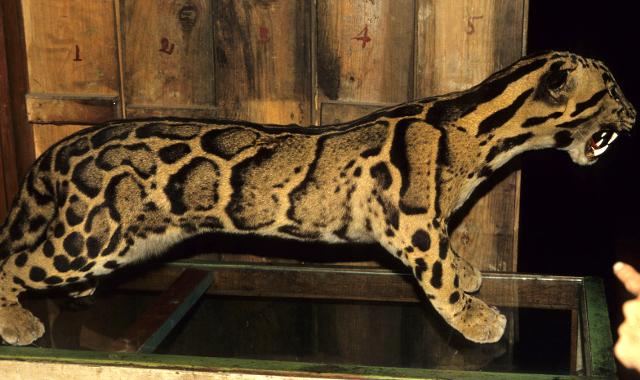
What can I say...He had at least three of these.
The next couple days my soul was invigorated slightly. We left the town for a bit and started to trek and explore one of Viet Nam’s few national parks, Nam Cat Tien, the last refuge for the Javan Rhino that was “re-discovered” there a few years earlier. Although the only thing we saw was a squirrel of unknown species, I did see some lovely forest. The Vietnamese did have dead, stuffed versions of the wildlife strategically positioned throughout the forest in semi-natural poses. I could not believe how unbelievably tacky this was, but this was how the Vietnamese decided to appreciate wildlife – kill it, stuff and put their contorted carcasses in the trees. Gotta love it. Oh, and we spoke to a ranger there about the Rhinos and he told us that they were hunted for their horns almost as soon as the news was out that they were re-discovered. He seemed pretty proud of this fact and how skilled the Vietnamese were at hunting. I started to lose any hope at all that there was any future left for the nature of Viet Nam.
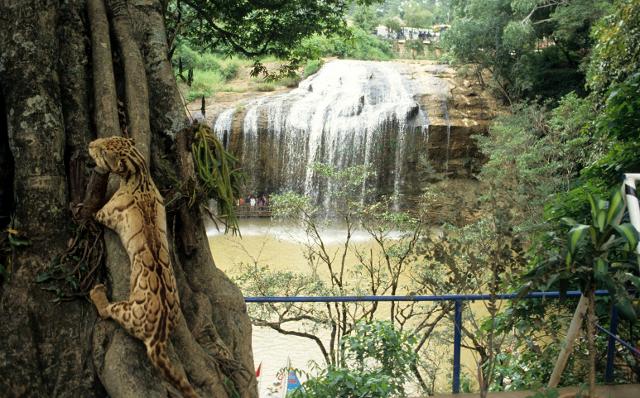
The Vietnamese version of wildlife viewing. Even the government was in on the poaching.
After our days in Dalat, we decided to continue our journey north. Lien’s aunt arranged transportation for us under threat of death if the driver were to screw us any way whatsoever! Actually the drivers she lined up were great. Vinh and Binh (from this point known as “Vinh and his kin Binh”) were outstanding drivers and ended up being great friends. They liked my Vietnamese and even appreciated my silly sense of humor.
We started our travels up north. We spent a couple days in almost every town we passed along the way. We visited Nha Trang and had killer sea food. In Quy Nhon, we spent time with another one of Lien’s countless aunts. This one was the mayor’s wife! I was impressed with all of the VC, communist memorabilia in her house. Lien’s conversation with her was distinctly different. The aunt wanted to know how much Lien’s family regretted leaving the motherland and what they planned to do to re-ingratiate themselves back in the good graces of the communist party. I am not sure exactly what Lien said to her aunt but we did part on happy and friendly terms.
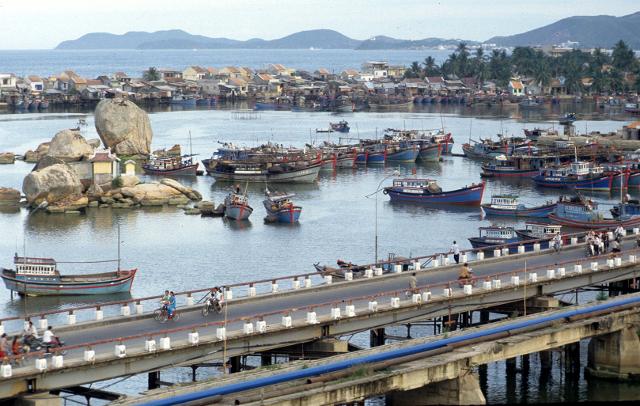
Nha Trang's fishing fleet
As we continued up coast a bit, I wanted to experience the central highlands and the hill tribal areas a bit more. We made some inquiries in the local towns on the coast and found out that the central highlands were now open to tourists and that we could in fact get there without permit. We took the first road possible up to Buon Ma Thout. Now this was a serious trip back in time. There were no paved roads which made travel there in the rainy season in a 2-wheel drive van a bit challenging. We eventually made it. We spent the next three or four days exploring this amazing area.
The absolute highpoint for me was a simple solo trek I took a few miles down a muddy dirt road one afternoon. Lien wanted to take it easy in our hotel for the afternoon and I was as restless as usual. I decided to go for a stroll and I noticed a dirt road with my name on it! As I started the trek, it was nothing particularly out of the ordinary. I heard the normal calls of “ling so” and felt the incessant stares and gawking. But after it was clear I was way off the beaten path, I became aware that I was in an area where the people had not ever seen a white guy... ever. A crowd of curious Ede Tribal members started to approach me. They were genuinely curious, so I knew there was nothing to worry about. Initially there numbers were in the single digits but within twenty minutes or so, there were dozens if not over a hundred people following every step I made! I became a serious spectacle! I was not inexperienced with this sort of event, as I have often stood out in my travels, but this afternoon it was extreme. People were calling in the fields and homes we passed and screaming Ede-language at their friends and neighbors to come and see the white devil! (At least I think that is what they were saying…). Ladies were even offering their daughters to me, jokingly, I think. This trek was one of the more memorable walks I have ever taken. It was dark by the time I made it back. Lien was beside herself with worry. I profusely apologized, but after hearing the story, she was amused and all was good again.

"Take my daughter!" I wasn't sure if this Ede lady was kidding or not.
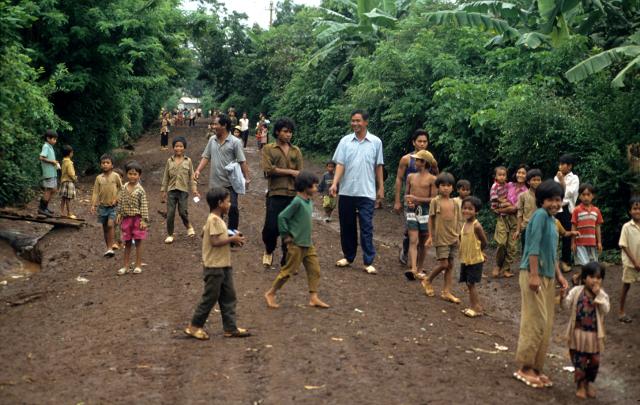
Note how many villagers are coming in from all over the countryside to see the "Ling So".
After Buon Ma Thout, we continued in to the Ede tribal lands along the road to Pleiku. We spent just one day in Pleiku. The area around here was still riddled with land mines and downed US planes and burned out tank carcasses. Not much had changed here since the war over 20 years ago. This was surreal. I was feeling some pretty intense and negative vibrations here and basically I could not get out of Pleiku fast enough.
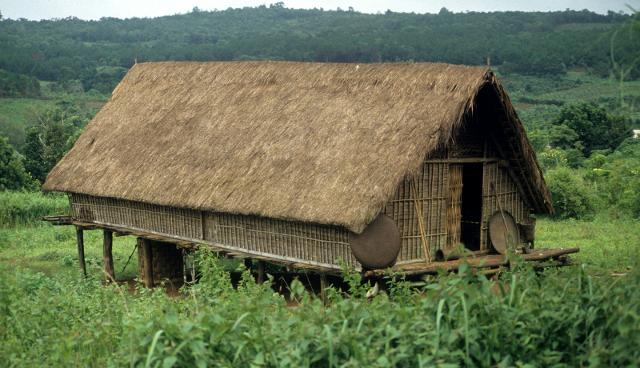
The Ede are a matriarchal culture. They have one windor for each married daughter. This longhouse has one.
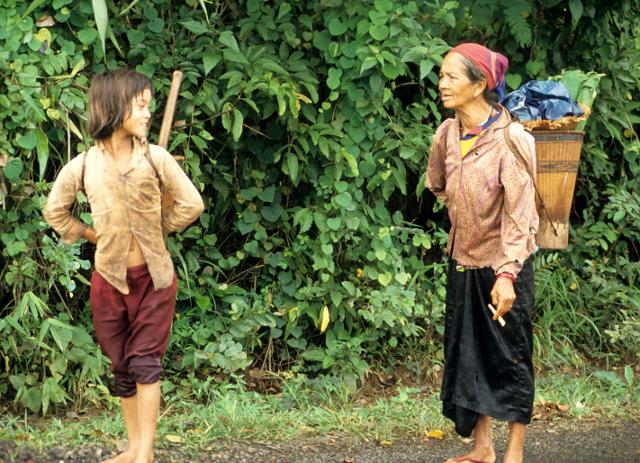
I stopped to ask if I could take thier picture. The elderly lady did not speak Vietnamese, so her grand daughter had to translate. The lady replied, "no". Oops...
And to make matters even worse, as far as negative vibrations are concerned, our next destination was My Lai, the site of one of the worst US massacres that was documented during the Viet Nam experience. I was a bit nervous about visiting this site as it was not exactly something I was proud of, being an American. We traveled through the beautiful and now peaceful rice paddies to the My Lai massacre site. Here we visited one of the most powerful museums I have ever experienced. By the time I left, I was in tears. The survivor-guide was very kind and gentle to me while he was showing us around. He took me out to the fields even showed me the ditches that were once filled with the bodies his grandparents, parents and brothers and sisters. He was shot and thrown in the ditch as well and left for dead by the Americans but survived buy pretending to be dead underneath his own sister. I simply cannot understand this sort of trauma. He seemed to be strangely at peace now however.
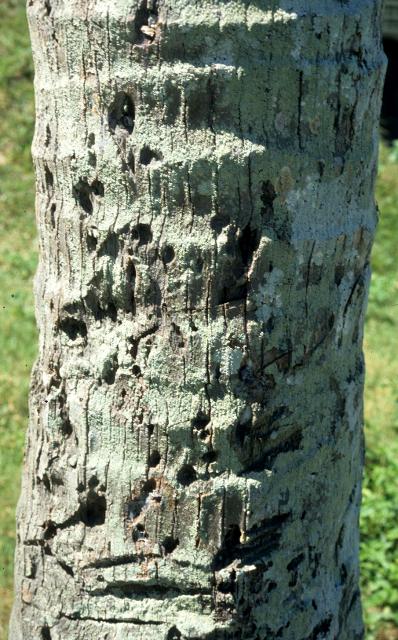
Bullet holes from the My Lai Massacre.
On the way out of My Lai, I could not bring myself to even speak about what we had just seen. Lien seemed happy being quiet as well. She was never very emotionally expressive, but I could sense that this place affected her as well. After a couple miles of traveling through the rough, muddy dirt road, a group of villagers noticed us in the car. They looked directly in to my eyes and immediately started to become very agitated. They raised their garden hoes and started to point them in my direction. I was lost. I thought I spoke a fair amount of Vietnamese, but I could only make out two words, “nguoi my”, “American”. I guessed correctly that they were angry that I was an American. Lien was becoming frightened as were Vinh and Binh! I was prepared though. I had thought of this contingency and I picked up my backpack that had a Canadian flag sewn on the front and said, “Toi khong la nguoi my. Toi la nguoi Canada!” This seemed to work. I told them that I was Canadian. And Lien and Vinh took the hint and started to explain to them in more detailed and correct Vietnamese that we were not Americans. This seemed to do the trick and we were allowed to continue on our way. We were all very shaken after this terrifying event. Vinh told Lien that we were very close to a potentially deadly situation.
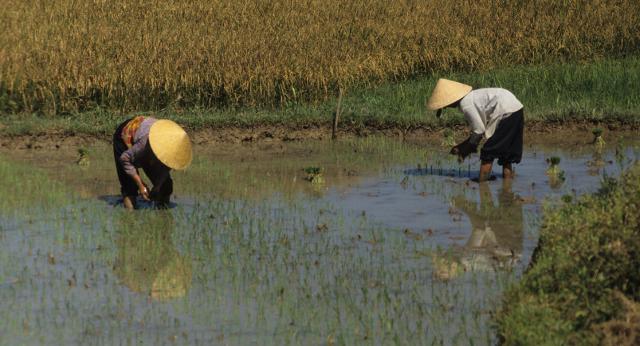
Villagers from My Lai
We continued our coastal highway progression north. After stopping for short exploratory trips at the various villages along the way, we finally made it to Hoi An where we hung out for several days in this lovely seaside town. The ambiance of Hoi An was artistic and unspoiled. I hear that it has changed since we where there so long ago, so I am glad we were there before it had changed. We rented a couple scooters one day and rode all the way up to the My Son ruins in the hills deep in to the countryside. Although these ruins were bombed heavily by the US in the war, they were still outstanding examples of Cham architecture and culture. It wasn't until after we returned to Hoi An that evening that I learned that the road to My Son was still riddled with land mines! I very much enjoyed this trip and recommend it to any of our friends who make it to Viet Nam. Strangely, none of our friends have actually ever made it there!
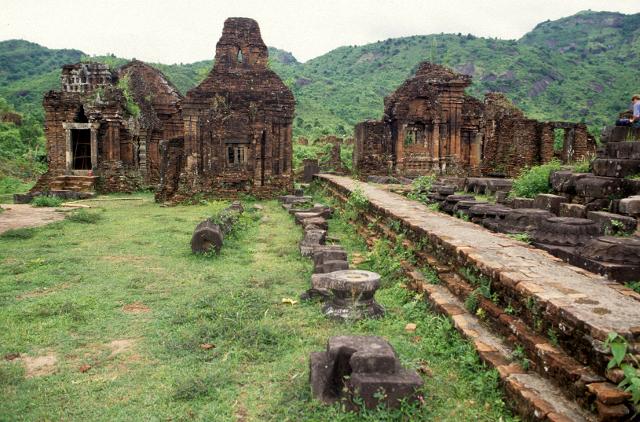
The My Son Cham Ruins. "We bombed them to save them."
As we proceed north, we stopped in Da Nang for a few more days R & R. While in Da Nang, we explored Marble Mountain, China Beach and some of the museums in the town. I was very impressed with Marble Mountain which was a pretty amazing VC hide out with perfect views of the GI hangout on China Beach. The paradoxes of the Viet Nam war were becoming more and more evident as we experienced more of its history first hand.
One of our main goals for this expedition was the ancient capital of Hue. Here we spent several days exploring the various tombs of the city as well as the Imperial Palace. The entirety of Hue was too much to take in. I had no idea about the extent of Vietnamese history until I experienced Hue and started to learn about all of the emperors and eras of Vietnamese history. It was here that I learned how Lien got her last name, Dinh. When we visited the Khai Dinh tomb, Lien educated me that her family was important during this dynasty and adopted the last name of their emperor, "Khai Dinh". Evidently this was a common practice throughout Vietnamese history which is why now the most common Vietnamese name is Nguyen.
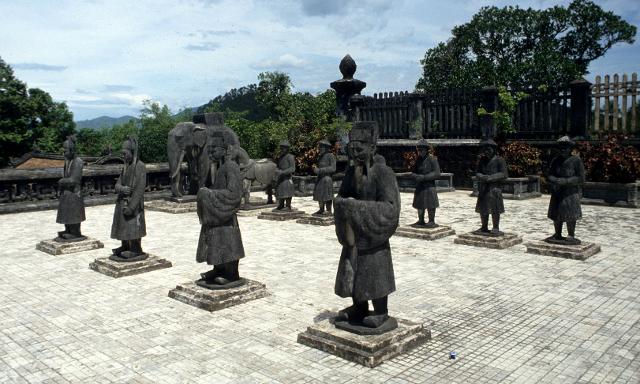
Khai Dinh Royal Tombs
I thoroughly enjoyed our time in Hue. We boated the Huong Giang River (Perfume River – I guess in Viet Nam, perfume must smell like human feces…) and had some great encounters with the boat-dwellers along the river. What a great day. While in Hue we of course ate the regional specialty, Bun Bo Hue. After sampling so many dishes in Viet Nam, both Lien and I came to the conclusion that Vietnamese food was much better in the US than in Viet Nam. The ingredients were better in the states I guess. I hear things are better now.
One late afternoon when I was relaxing in my 3-star hotel, the “Huong Giang”, I was watching CNN International. This was the first English news I had heard in over a month. After a few minutes of watching, a commercial break came on. Ironically, it featured an old war video clip of the Viet Nam war. I didn’t really think much about it until I started to study the scene more carefully. There were three or four GI’s firing their M16’s using the corpse of one of their comrades as a barrier between them and the VC who were firing from the far side of this bridge. I cannot remember exactly what was being advertised, but I started to notice that the bridge in the commercial seemed oddly familiar. As the commercial was still playing, I glanced out my window and noticed the bridge directly below my hotel. It was the same damn bridge that was in the film clip in the commercial! I was watching the footage of a fierce and deadly fire fight that had happened during the Tet Offensive in 1968, over 26 years before I was there. And it had happened on the bridge directly below my balcony!

The famous Hue Tet Offensive bridge.
The next day, we walked a part of Hue we had yet to visit. Here there were still a lot of relics from the Tet Offensive that had been basically left where they were abandoned so many years before. Aside from being stripped of anything of salvage value, they were basically just left right in the street where they died in battle. I was exploring one of the tanks and I noticed some graffiti left by the soldiers who had occupied it so long ago. I could not help but wonder what had happened to them. Did they die on the battle? Or did they simply abandon their equipment when the Americans retreated. I will never know.
After a truly educational experience in Hue, we continued north and visited the 17th Parallel and Khe Sanh. But in all honesty I was very much fatigued by all of the intense Viet Nam war flash backs by this point. Although I was not there and I had nothing to do with the “American War”, I was becoming overridden with feelings of guilt and shame. I wanted to enjoy myself a bit more...and maybe even see some nature!
And then we left Hue and headed north through Vinh and some of the poorest parts of Viet Nam. Oh yes, this would make me feel a lot better. The next three days, we worked our way through the most environmentally devastated and impoverished areas, not only in Viet Nam, but on earth. We drove by as some villagers were violently slaughtering a dog. That made me nearly sick to my stomach. A few kilometers later we came across a village that was about to do the same to giant Brurmese Python. During our meal stop along this long, horrible and desolate road, we tried to find a store with some food. There was none. We had wallets stuffed with Dong (Vietnamese currency) yet there was simply nothing available to buy. We stopped at one market after another and the scene was the same, one village after another. This was the first time I had ever experienced this level of poverty. Finally after nearly a full day with no food ourselves, we made to a store with some supplies – ancient biscuits and condensed milk. We were starving so we weren’t really that concerned about the mold on ancient biscuits. We survived on these tasty treats for the next day or so until we finally made it to Vinh.
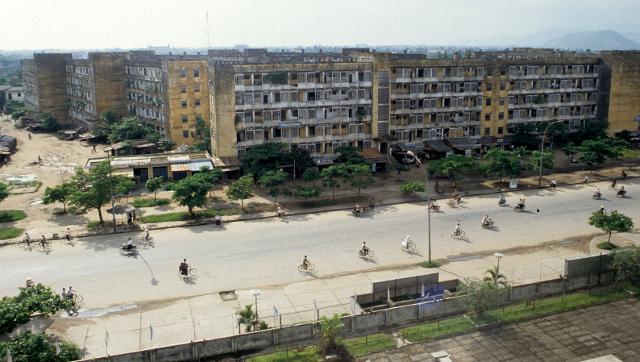
The "glorious" East German city of Vinh
Vinh was a disgustingly ugly, East German monstrosity of a city. Much of the infrastructure of Vinh was a gift from East Germany and was crumbling before our very eyes, even though every building in town was only about ten years old. Communism at its finest I suppose. We weren’t allowed to leave our hotel after dark as the town was famous for its violence. I read later that the town was home to thousands of criminals as a few years earlier, the army basically stranded thousands of its completely broke and unpaid soldiers there with no way to get out. Many turned to crime which now made Vinh a very dangerous place. We obliged by staying in our hotel and stuffed our faces with the plentiful, albeit very mediocre Vietnamese food. We didn’t care, there was lots of it!
We got out of Vinh and this part of Viet Nam as soon as we could speed up north. Our next destination was Cuc Phuong National Park in the hills south of Hanoi. We arrived in time to contract a cook, a guide and provisions for about a week in the bush. We then entered this spectacular primary forest. I knew then that all was going to be fine again. I was finally going to be rewarded with a glimpse of wild Viet Nam and gain a sense of the wilderness that once was. The forest was simply too pristine looking not to be filled with fauna. Alas, I had another lesson to learn about environmental destruction, Asian style.
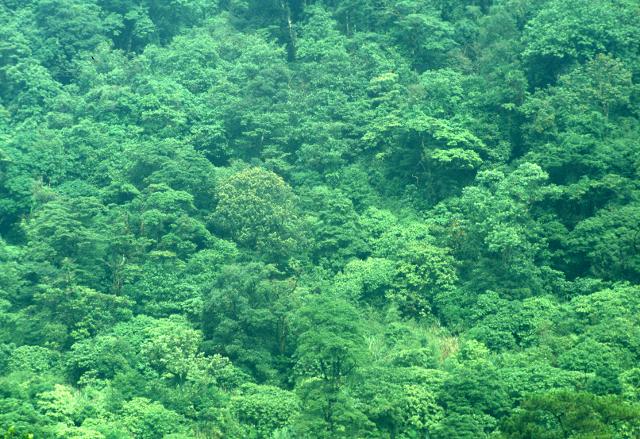
The silent Cuc Phuong Forest, ever so quiet.
While I had read of the phenomenon known as the “Silent Forest Syndrome”, I could not appreciate it clearly until I visited Cuc Phuong National Park. There was not one bird in the entire forest. There were virtually no insects and definitely no living mammals. After four days trekking this otherwise superb forest gallery ecosystem, I was blown away that the poachers could have that thorough in catching every single living thing. The “Silent Forest” is a reality and it is in Cuc Phuong. I would love nothing more to learn that things have gotten better in Viet Nam, but so far…
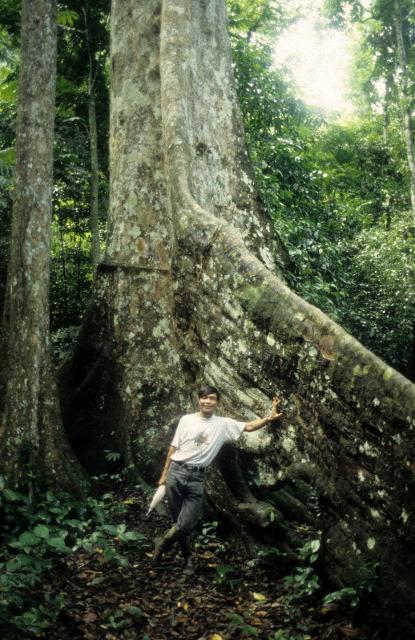
Lien's uncle next to an old growth giant in Cuc Phuong.
We then headed further north for a few days in the “Paris of the Far East”, Hanoi. Hanoi is definitely a world class city on many levels. The architecture and the scenery made our five night stay there well spent. I enjoyed viewing sights like the “One-pillared Pagoda”, Ho Chi Minh’s Tomb and other places. We even hooked up with Lien’s uncle who was our escort for several days while in the north. He was a nice guy for sure but he really was hoping that I would be his business partner more than anything else. I was able to very effectively pretend not to understand Vietnamese when it suited me…
We got out of Hanoi for a few days and visited Ha Long Bay. We spent two days cruising the bay, its islands and grottos. What a spectacular spot. It is like Guilin, China only with water surrounding the karst mountains. Environmental degradation is pervasive there as well but the landscapes are sublime. We were able to visit some of the islands and actually pick up a new mammal species for me – Stump-tailed Macaques. Sadly, this trip produced a very poor species list. Even with very three very in depth months of travel, we came across barely 20 species of birds and one or two mammal species. I sure hope the situation has improved in the years since I was there.
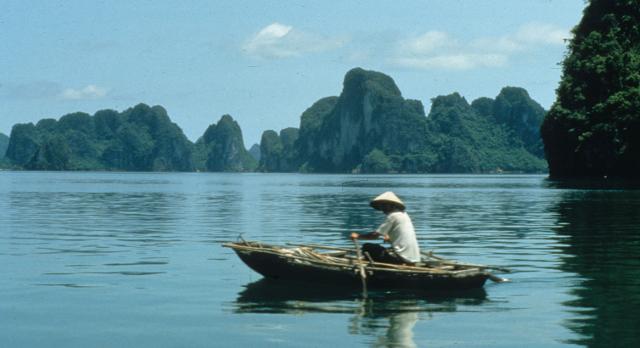
The karst topography of Ha Long Bay
We spent our remaining time in the north visiting Sapa, Den Hung and Tam Dao Station. In these places we experienced some fascinating hill tribes, nice forest, some amazing insect collecting in Tam Dao and the birth place of the Vietnamese tribe in Den Hung. I had finally adjusted my expectations of the expedition to adapt to the realities of post war, post VC Viet Nam. I came to be at peace with these facts and finally started to really enjoy myself.
While in Tam Dao, we hung out at a home that was owned by a retired five-star general who had worked directly under Bac Ho Chi Minh himself. Wow did we have some amazing conversations. Thankfully Lien was equally interested and was a great translator of these intense discussions. The topics ranged from Ho Chi Minh, the man, the Ho Chi Minh Trail, the American MIA’s, the communist party and his opinions of the war and the “victory”. And all of this coming from one of Ho Chi Minh’s right hand men!
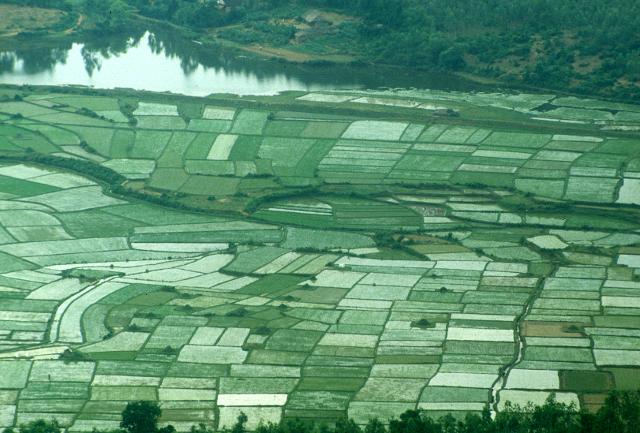
The view of the Red River Valley from Tam Dao Health Resort
He told us how he had seen many of our soldiers dead on the Ho Chi Minh trail during his many years along the trail. He knew that some of the MIA’s could be repatriated but most were, in his words, “tiger food”. He told us of more than one of our boys’ corpses being eating by jackals or tigers. This was enlightening. He told us how he was furious at the lies told to him and the nation by Ho Chi Minh and the party leaders. He felt that all he fought for; all that so many millions of “his children” died for, was for a pack of lies perpetrated by Ho Chi Minh and the communist party. He said he wished the Americans had won the war so we would have rebuilt the nation, and “Viet Nam would now be as rich as Thailand, not the poorest country in Asia!” I was fascinated with this man and his perspective. I thought that someone needed to take this man’s life story and write it down for a fascinating book.
After nearly two months on the road, we were ready to head back down to Saigon. I was not in the mood for another 1000 mile road trip from hell, so we took the hour long flight on Viet Nam air, known for being one the world’s most dangerous airlines. We were pleased to see a brand new Boeing 737 with every seat being nearly first class and being flown by handsome French pilots. It was actually one of the nicest flights I had ever experienced.
Our time in Saigon was spent with more quality time with Lien’s family. I took some time off work and continued our stay there until the fall. My Vietnamese was starting to get quite good by this point, and I was having a much more relaxed time. Lien was making peace with her history and the trauma that her family experienced during the war. Her memories were vivid and powerful, and before we actually traveled to Viet Nam, they were very much out of context. But after our in depth multi-month experience in her homeland, she told me that she felt Vietnamese again. She no longer felt like a fish out of water. She was now at peace with the fact that she was bicultural; that she was American and she was Vietnamese. Although to the local Vietnamese, she would always be Viet Qu (a returning Vietnamese), she was now OK with this. She had a clearer perspective of who she was and I could sense that this made her a much happier and more satisfied person. I will always cherish sharing this growth experience with her. I wish she had been able to take this journey to a further level but she died two weeks before being able to visit Viet Nam again. I will never forget a discussion she had right before she was supposed to go back to Viet Nam in the summer of 1998: “I am not sure exactly what my purpose is for going back; I just know that there is more for me to experience there; more for me to grow in knowing who I am.” She died two days later.
Be sure to visit our Photo Galleries for more spectacular images of our travels! (Pbase Galleries)
Here are some more images of our amazing stay in Viet Nam in 1994.
